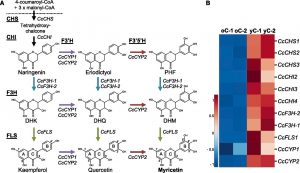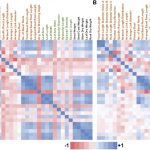Synthesis of a Plant-Based Drug for the Potential Treatment of Type-2 Diabetes
Type 2 diabetes, which is characterized by high blood glucose (Glc) levels, afflicts ~6% of the population of the western world. A major goal in treating diabetes is reducing high levels of blood Glc, which is a particular problem in patients whose diets are rich in starch and other sugars. The main enzyme of starch degradation is human pancreatic a-amylase (HPA). In a large-scale screen of 30,000 natural products for HPA inhibitors, the  complex acylated flavonol glycoside montbretin A (MbA) was discovered to be a potent and specific amylase inhibitor. MbA was also found to control blood Glc levels in Zucker Diabetic Fatty rats. These promising preclinical findings require the development of methods for producing large quantities of MbA for further drug development. The only known source for MbA is the corms of the ornamental plant montbretia (Crocosmia X crocosmiiflora, family Iridaceae). The low amounts of MbA in montbretia corms, lack of agricultural production systems for this plant, and the destructive harvest of the belowground corms make it unrealistic to support MbA production via cultivation and harvest. The complexity of the MbA molecule mitigates strongly against production by classical synthesis. Production by synthetic biology appears a viable approach, but it requires knowledge of the genes and enzymes of the MbA biosynthetic system. The research aim of Irmisch et al. (10.1104/pp.19.00254) is to metabolically engineer Nicotiana benthamiana using montbretia genes to achieve increased production of and MbA. Two montbretia UDP-dependent glycosyltransferases (UGTs), CcUGT1 and CcUGT2, catalyze the formation of the first two pathway-specific intermediates in MbA biosynthesis, myricetin 3-O-rhamnoside and myricetin 3-O-glucosyl rhamnoside. In previous work, expression of these UGTs in N. benthamiana resulted in small amounts of kaempferol glycosides but not myricetin glycosides, suggesting that myricetin was limiting. Here, the authors report that the transient expression of combinations of montbretia flavonol biosynthesis genes and a montbretia MYB transcription factor in N. benthamiana resulted in availability of myricetin for MbA biosynthesis as well as detectable levels of MbA.
complex acylated flavonol glycoside montbretin A (MbA) was discovered to be a potent and specific amylase inhibitor. MbA was also found to control blood Glc levels in Zucker Diabetic Fatty rats. These promising preclinical findings require the development of methods for producing large quantities of MbA for further drug development. The only known source for MbA is the corms of the ornamental plant montbretia (Crocosmia X crocosmiiflora, family Iridaceae). The low amounts of MbA in montbretia corms, lack of agricultural production systems for this plant, and the destructive harvest of the belowground corms make it unrealistic to support MbA production via cultivation and harvest. The complexity of the MbA molecule mitigates strongly against production by classical synthesis. Production by synthetic biology appears a viable approach, but it requires knowledge of the genes and enzymes of the MbA biosynthetic system. The research aim of Irmisch et al. (10.1104/pp.19.00254) is to metabolically engineer Nicotiana benthamiana using montbretia genes to achieve increased production of and MbA. Two montbretia UDP-dependent glycosyltransferases (UGTs), CcUGT1 and CcUGT2, catalyze the formation of the first two pathway-specific intermediates in MbA biosynthesis, myricetin 3-O-rhamnoside and myricetin 3-O-glucosyl rhamnoside. In previous work, expression of these UGTs in N. benthamiana resulted in small amounts of kaempferol glycosides but not myricetin glycosides, suggesting that myricetin was limiting. Here, the authors report that the transient expression of combinations of montbretia flavonol biosynthesis genes and a montbretia MYB transcription factor in N. benthamiana resulted in availability of myricetin for MbA biosynthesis as well as detectable levels of MbA.



